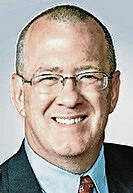The fourth anniversary of COVID offers an economics columnist a rich set of policy lessons. Among the most pressing is the political economy of inflation. I begin by reminding readers that inflation is largely a policy choice, involving a trade-off between either increasing unemployment or reducing the purchasing power of our dollar.
This trade-off isn’t a constant like gravity or the speed of sound. It varies with the type of economic shock and the structure of the economy. Predicting the magnitude of this trade-off is like forecasting the number of hurricanes in 2024 by using just one previous year of data.
The collapse in economic activity that accompanied COVID preceded government action. For example, here in Indiana consumer spending hit its low point a week before Governor Holcomb issued his ‘stay at home’ orders.
The size of the COVID economic shock suggested a very deep and potentially lasting recession, with unemployment rates much higher than the Great Recession of 2007-2009. One implication of this is that the trade-off of employment for inflation was reasonably small. In other words, we could avert very deep job losses with modest inflation.
In April 2020 unemployment hit 14.8%, its highest point since the Great Depression. The folks who do the estimates that advise economic policy were nearly uniform in their calls for significant stimulus. They included economists in the Council of Economic Advisers, the Office of Management and Budget, the Congressional Budget Office, the Federal Reserve, think tanks, universities and private forecasting firms. Myself included.
It turns out we were largely correct. The unemployment rate came down rapidly after the first stimulus and Payroll Protection Plan checks were mailed. Within a year it was down to 6.1% and within two years it was below 4%. That brought us to the longest stretch of below 4% unemployment in 54 years. That is where we remain today.
There was a trade-off, though. Inflation spiked, and on a month-to-month basis got near its 2005 levels. We had about six quarters of inflation where price level changes were worse than they’ve been since the late 1980s. Still, we never got anywhere close to the inflation of the 1970s or early 1980s.
The effects of inflation were more modest than in past rounds. By 2023, wages had grown faster than goods and services inflation. So, households are on average better off in purchasing power today than they were before COVID. Moreover, household savings are higher and inflation-adjusted wealth is now at an all-time high. Mortgage rates didn’t return to 1970s levels as some feared, but only to 1999 levels before dropping late last year.
For the economic profession and those who structure policy, this was a very valuable lesson. We dodged what was likely a significant and lasting downturn for an uncomfortable, but historically modest bout of inflation. Sadly, that is unlikely to be the lesson political leaders take from this round of inflation.
Despite considerable evidence that the U.S. economy is performing better than it has in a half-century, public opinion polls show American consumers view it as dismal. In fact, the pools have been so bad, I think it unlikely that any future administration will take the same risks we did during COVID.
It seems very plain to me that the public seems to prefer high unemployment to high inflation. You see, inflation visibly affects everyone, while unemployment is far less visible. So, many folks just don’t think about the trade-off between job losses and inflation. But, they are pretty easy to quantify in retrospect.
The best study of the inflation-unemployment trade-off finds that an increase in unemployment would reduce inflation by about one-third of 1%. Most other studies are in this ballpark. Today, prices and wages are both about 14% higher than we’d have expected without the big burst of inflation we saw after COVID. That means to have prevented that unexpected inflation, we’d have needed to increase the unemployment rate by a tad bit more than 10% in each of the four years since COVID.
In other words, we could’ve maintained price stability, or constant 2% inflation per year over the past years. The trade-off would’ve been unemployment rates of 18% in 2020, 15.4% in 2021, and roughly 14% over the past two years.
Even if these estimates overstate the effect by 50%, this would have meant an additional 7.3 million unemployed Americans through each of the past four years. The study just as easily could have understated the impact by 50%, which would’ve given us annual unemployment rates rivaled only by the Great Depression.
I’m not suggesting anyone should love inflation or listen to what economists say about how to feel about the state of the economy. I certainly don’t. I simply suggest that when you think about the ill effects of inflation, that you also consider what the likely trade-offs would have been. For most of us, that will make the inflation seem a lot more palatable.
Michael J. Hicks is the director of the Center for Business and Economic Research and the George and Frances Ball Distinguished Professor of Economics in the Miller College of Business at Ball State University.





